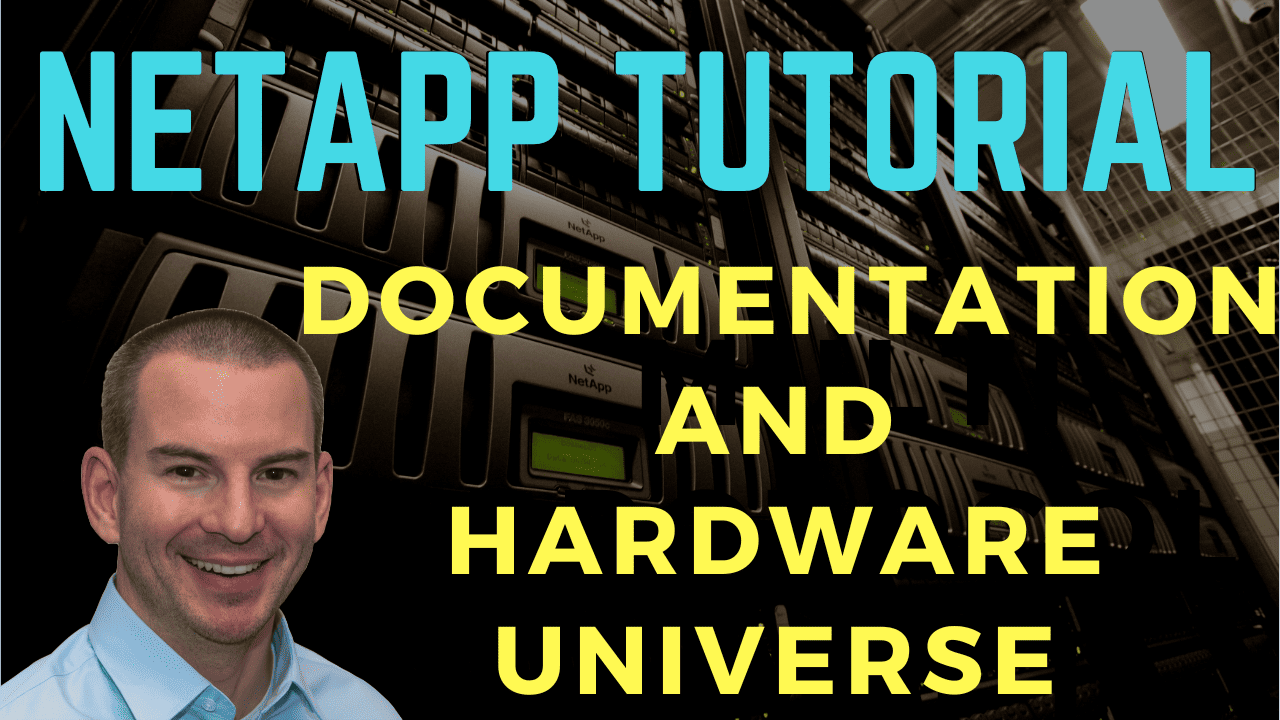
In this NetApp training tutorial, I’ll show you where to find and how to navigate the NetApp documentation. I’ll also show you the Hardware Universe webpage, where you can find full details on all of NetApp’s hardware and compatibility information. Scroll down for the video and also text tutorials.
NetApp Documentation and Hardware Universe Video Tutorial

Eleonore Lang

I passed the NCDA exam after taking your course, it took me 2 months.
I’d taken a new Storage Engineer position where the requirement was to obtain the certification and I was given exactly 90 days to obtain it.
I wouldn’t have done it without your course!
On the homepage at netapp.com, click on Sign in, and then click on Support. At this point, it will normally ask you for a username and password. You can sign in here with just a guest user account.
Click on Docs and Knowledge Base, followed by A to Z Documentation. Here, you'll find all of NetApp's different products and services.
Under D, we've got disk shelves. You can go there to find the hardware information about the disk shelves with the cabling guides. If I go back up to A, you'll see the AFF Series, and you can find the hardware information about the hardware platforms and, again, the cabling information. We have the same information for each of the various FAS models.
Under O, I'll go to ONTAP 9 and open up that in a new tab. This gives you all of the different software configuration guides. Something I love about the NetApp documentation is that you can select the zip format, which will download all of the different documents. They come as a PDF.
There are many PDFs from other vendors, and downloading them one at a time is inconvenient if you want a laptop library of all the documentation. On the NetApp website, click zip, and you can download all of those different PDFs as one zip file. It's super convenient.
I'll click on "All Documents" here, and you'll notice that there are numerous different PDFs. With their naming format, it's easy to see what each of the different PDFs is about. For example, the transition guide for transitioning to ONTAP. That's for migration from 7-Mode to clustered ONTAP.
You can view disk and aggregate configuration instructions, among others. There are separate PDFs available for nearly every task you may need to perform. The documentation is well written. All of the guides are very short, to the point, and concise.
NetApp also has another way you can get the documentation. Simply navigate to netapp.com/support-and-training/documentation/ to access your AFF, FAS, and ONTAP systems on a separate page.
Personally, I don't come here very often, unless a Google search has led me here. I prefer to download all those PDFs and then choose the one I need.
NetApp Hardware Universe
Hardware Universe differs from the documentation site in that it is not publicly accessible. You just need to sign up for a guest user account. To get into Hardware Universe, you need to have a user account, which is a customer or a partner-level account.
The URL is simple to remember. It's just hwu.netapp.com. There's a menu across the top for all of the different types of NetApp hardware.
If I click Platforms, I can see all the platforms. I can also inspect various adapters, such as Ethernet cards and fiber channel cards, as well as various shelves, drives, cabinets, switches, and cabling. Additionally, I can compare various storage systems.
Additionally, on the dashboard's front page, there are links to download PDFs. The HWU poster is quite useful. You can print that out as a big poster, and it will give you summary information about all of the different NetApp platforms.
You can also see the recent queries you've run in Hardware Universe, allowing you to pull that information back up. At the top right, we have Hardware Universe News, as well as the FAQ for frequently asked questions.
Let's assume that I'm interested in learning more about the AFF platforms. Therefore, I will choose the All Flash FAS option, which not only displays current models but also provides historical information. It's also very easy to find compatibility information in here if you're unsure if an older piece of equipment will work with a newer piece of equipment.
Let's say I'm working only on ONTAP 9.5 right now, so I'll select that. It will show me all of the platforms that can run ONTAP 9.5. So, let's select the AFF 700 and give this a few seconds to load. I'd also like to see information about the AFF A300 on the same page.
I'll also select that option and then click on "Show Results." This provides me with comprehensive and detailed information. Almost all the information I require about the controllers is available.
Once it's done, I'll scroll down. I'll come back to the top. You can view the maximum raw capacity and the maximum number of devices, among other details. A little further down, you can see the CPU, memory, NVRAM, and the on-board interfaces, among other things. You can also find environmental information further down.
You also get all of the maximums, such as how many nodes you can have in a cluster, how many volumes, how many aggregates, etc. Almost all the information you need is available. If I scroll back up to the top, you can see that we are once again provided with information about the supported shelves and the drives that are compatible with each shelf. If those controllers have expansion slots, they also support adapter cards.
Additional Resources
What is NetApp HWU and NetApp IMT tools: https://kb.netapp.com/Support/General_Support/What_is_NetApp_HWU_and_NetApp_IMT_tools
ONTAP Hardware Systems Documentation: https://docs.netapp.com/us-en/ontap-systems/
NetApp Product Documentation: https://www.netapp.com/support-and-training/documentation/
Libby Teofilo

Text by Libby Teofilo, Technical Writer at www.flackbox.com
Libby’s passion for technology drives her to constantly learn and share her insights. When she’s not immersed in the tech world, she’s either lost in a good book with a cup of coffee or out exploring on her next adventure. Always curious, always inspired.